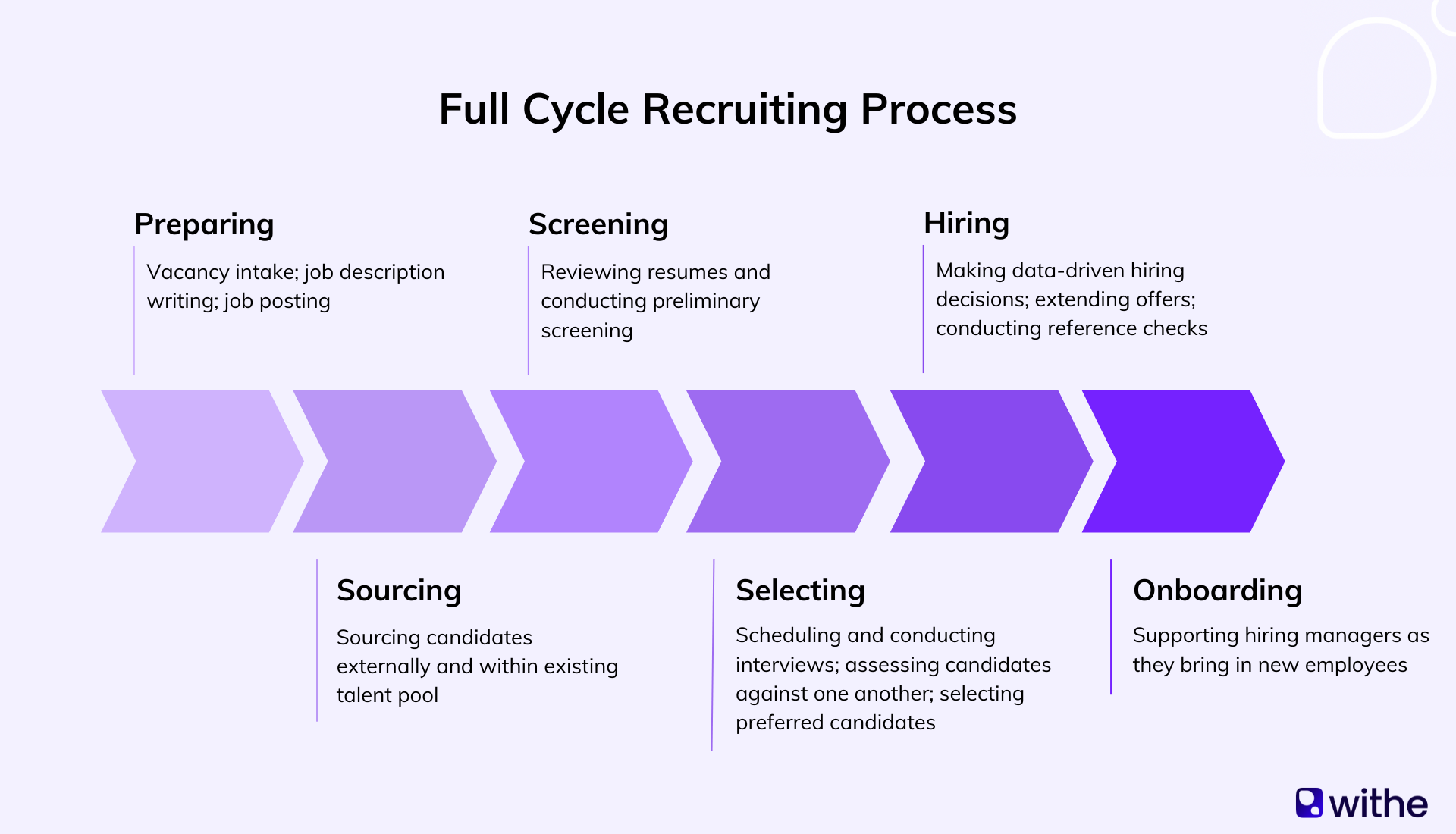Leverage Withe's hiring event platform
Streamline your seasonal and high-volume hiring process and hit your hiring targets.
When it comes to work and how it gets done, a lot of companies are opting for a hybrid approach that allows for both remote and in-person experiences. But how does this approach channel into recruiting?
While virtual recruiting has become increasingly popular (and vital) for hiring teams, there is a growing need for a hybrid approach that accounts for various candidate needs and expectations. Plus, teams might find that a blend of virtual and in-person recruiting practices is the ideal approach for hiring in their industry.
In this post, we’re taking a closer look at what hybrid recruiting is, its benefits and challenges, and strategies for getting it right from the get go.
Leverage Withe's hiring event platform
Streamline your seasonal and high-volume hiring process and hit your hiring targets.
What is hybrid recruiting?
Hybrid recruiting is an approach that includes both virtual and in-person recruiting practices. How teams choose to divide their many recruitment tasks between online and in-person approaches really depends on their industry, the types of roles they’re trying to fill, any hiring metrics they’re looking to improve on, and the feedback they receive from their candidates. That said, regardless of the distribution, the approach to hiring should be seamless and integrated so that data can be shared easily and decisions can be made quickly.
When compared with traditional hiring practices, hybrid recruitment adds virtual and automated features that can help accelerate the candidate journey and increase the chance of a preferred applicant accepting their offer. Even if most of your interactions with candidates are in person, your hiring process could still be considered hybrid if candidates can schedule their interviews online, or if you use video interview software to accommodate a hiring manager that operates out of a different location.
Where does hybrid recruiting happen in the hiring journey?
The hiring process is typically split into six parts: preparation, sourcing, screening, selecting, hiring, and onboarding.

Each of these steps can be made hybrid by introducing digital tools and solutions to the process. Again, how you distribute your approach will be up to you and your business, but here are some ways that teams tend to split up their virtual and in-person approaches.
- A blended hybrid recruiting approach where virtual and in-person recruiting is used at strategic parts of the funnel. For example, recruiters might use virtual recruiting at the top of the funnel and then shift to in-person interactions for final interviews.
- A composite hybrid recruiting approach leverages both virtual and in-person interactions in parallel throughout the funnel. This could look like having both in-person and virtual hiring events on the same day or within a day of each other.
- A synchronous hybrid recruiting process combines virtual and in-person elements into the same events. For instance, candidates could sign up and schedule an interview at a hiring event online, and then attend in person.
Using a hiring event platform like Withe, recruiters can have candidates sign up virtually and track where they came from. They can then also use Withe to give each candidate a score or assessment once they interview a candidate, and that information is integrated into their ATS.
Related resource: How to scale your high-volume hiring with virtual hiring events
Top benefits of hybrid recruiting
Implemented effectively, a hybrid approach provides the best of both worlds. It offers the flexibility and accessibility of the virtual experience, with the much-needed opportunity for human interaction that comes from the in-person experience. Plus, candidates can feel more confident that they are engaging with a real, trusted company.
In more detail, these benefits include:
1. A broader candidate pool
Introducing virtual practices into your hiring process can help you reach candidates that are outside of your area — especially if you use virtual interviewing.
That said, some companies or industries might prefer conducting interviews and hiring events in person because that better reflects their hiring needs. For example, restaurant chain owners can better guarantee that an individual is able to work in person at a given location if they can meet in person beforehand. A hybrid approach is still valid here if you’re using technology to track applicants and their sources.
2. Increased accessibility
Hybrid recruiting is also more accessible to more candidates. For instance, introducing virtual screening calls at the top of the funnel can make it easier for parents that are unable to find childcare or individuals that can’t take a sick day from their current job. These individuals can then choose to make an investment for an in-person interview closer to the offer stage.
In addition, having virtual steps in the process can also make the process easier for people with disabilities who may not be able to access certain places or are more comfortable interviewing from home. This opens the door to a large pool of potential candidates that are often overlooked, and can make your hiring practices more diverse.
Note: These virtual steps in the process need to be paired with plenty of opportunities for candidates to request accommodations.
3. Future-proofing your recruitment strategies
A hybrid approach to recruiting will ultimately make your process more agile and adaptable. If you’re using various tools and practices to get in front of candidates and bring them into the workforce, you’ll be better prepared for any big shifts that may impact your talent pools or how you hire.
4. Improved candidate experience
A well-crafted hybrid experience simplifies processes, improves communication, and helps to meet candidate needs proactively within the context of your industry. These are all things that improve the candidate experience and make it more likely for them to accept an offer when it’s presented to them. At the end of the day, hybrid recruiting provides flexibility so you can accommodate candidates and continue to improve the experience as you learn more about their needs.
5. Increased speed and efficiency
The right blend of in-person and online tactics will ensure that your team is moving as efficiently and effectively as it can. This will help reduce time to hire, enhance your offer acceptance rate, and support you in building a reliable talent pipeline.
Withe's hiring event platform helps recruiters build hybrid recruiting strategies that are best suited for their business
Common challenges in hybrid recruiting
While hybrid recruiting — and the flexible approach it provides — does make sense for most businesses, it can present some challenges. These include:
- Cost. A hybrid approach to recruiting is bound to save you money in the long run as it makes recruiting more efficient and effective. That said, there will be an initial investment in adopting new software.
- Time. Landing on a hybrid recruiting strategy takes time. It’s an iterative process that will require gathering feedback from candidates and recruiters alike to get right.
These challenges may feel like a burden at different parts of your hybrid journey, but they’ll be well worth it once you find your hybrid recruiting sweet spot.
Best practices for building a hybrid recruiting strategy
As you build your hybrid recruiting strategy, consider these best practices:
Start with an objective
Just trying out a hybrid approach for the sake of trying it out isn’t going to get you anywhere. Because of the flexibility and optionality in this approach, it can be very easy to get lost and overwhelmed if you don’t have a North Star to follow. Set an intention for what you want to accomplish, with clear goals and measurable objectives, and make choices in accordance with them.
Keep your target candidates in mind
As we suggested above, your hybrid recruiting strategy should serve your candidates above all. Leverage any feedback you’ve received from past candidates, and engage your current employees to determine what works and what doesn’t in your current processes. Use this information — and other data you know from your target market — to shape your hybrid approach.
Make intentional choices around your software
As you build your hybrid recruiting strategy, you’re going to need a hiring tech stack that is integrated and has a seamless flow of information. Choose tools and platforms that empower your team with automation, strong data analysis, and ease of use.
The future is hybrid — even in recruiting
If there’s something we’ve learned from operating in the recruitment industry, it’s that this space is always changing. Candidate expectations are constantly evolving, new technologies can easily disrupt how things are done, and forward thinking recruiters want to remain proactive in a competitive talent market. Taking a hybrid approach means that your team can remain agile and adaptable to these changes, therefore remaining competitive.
Withe’s hiring event platform helps recruiters build hybrid recruiting strategies that are best suited for their business. Learn more about our product.




